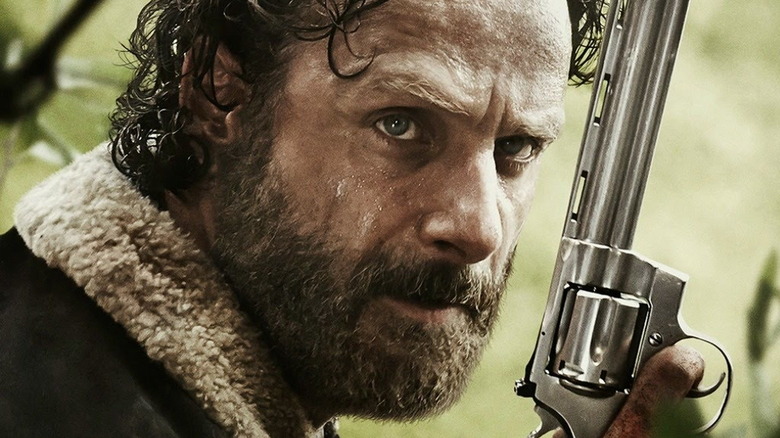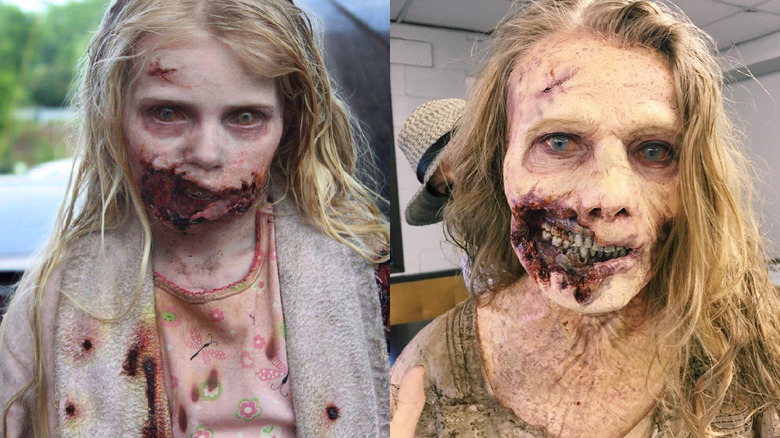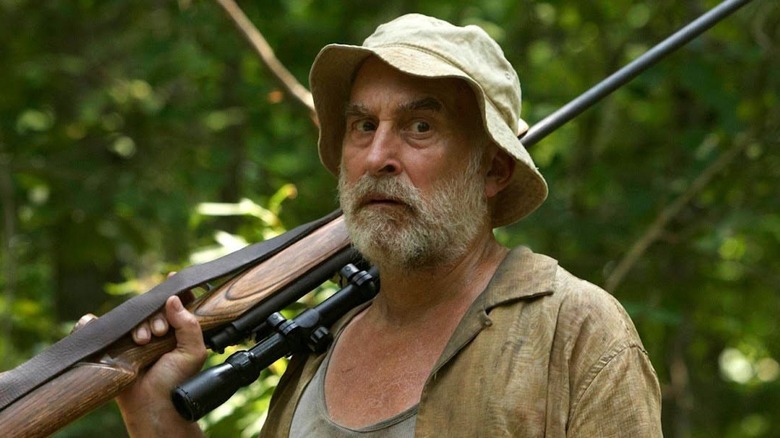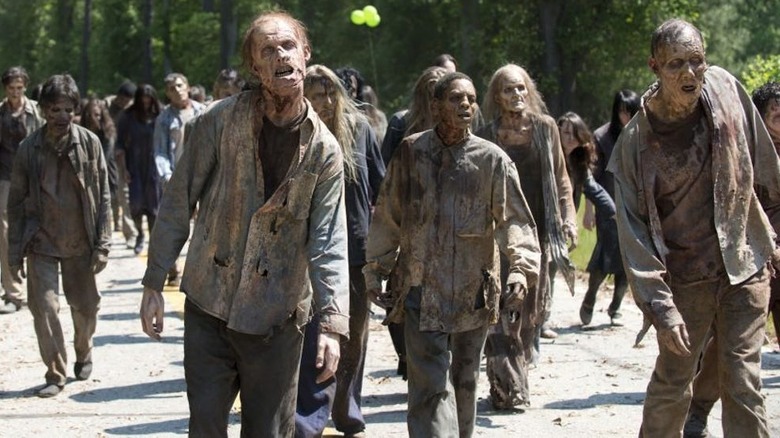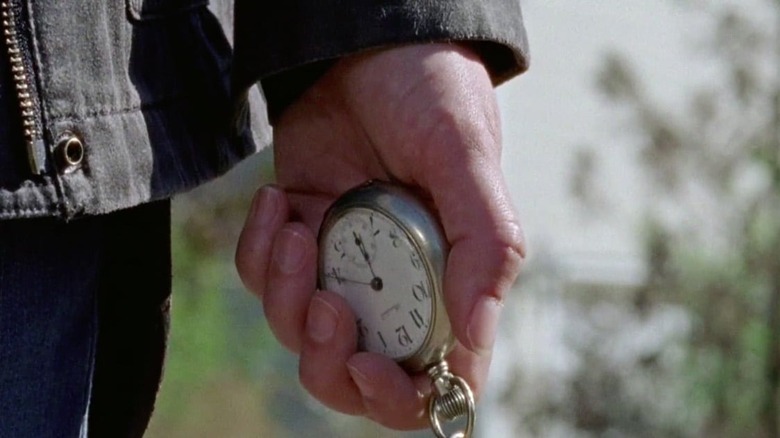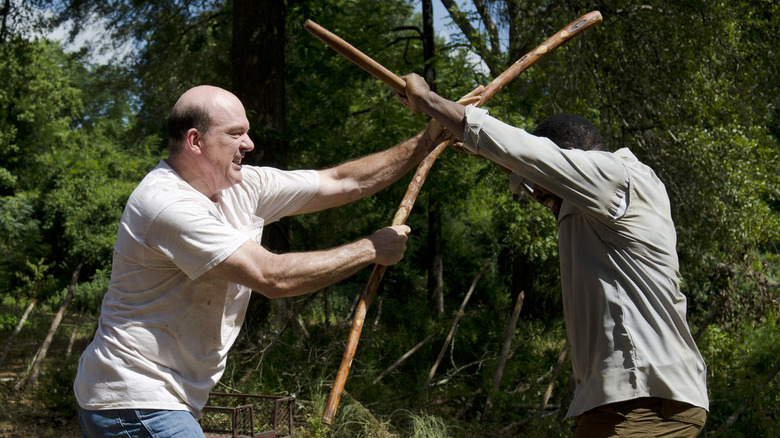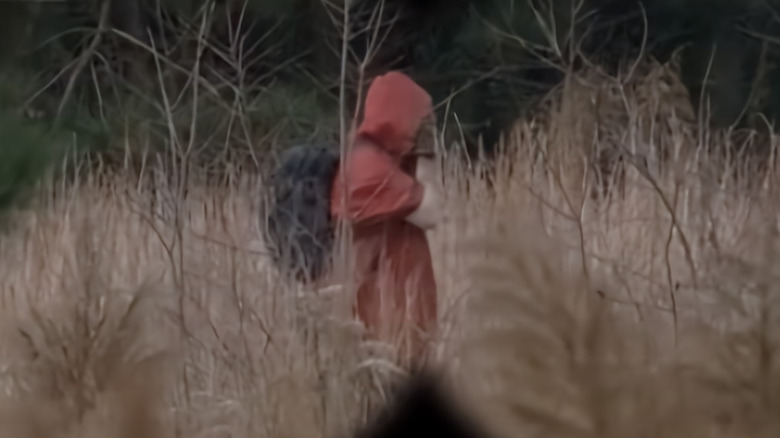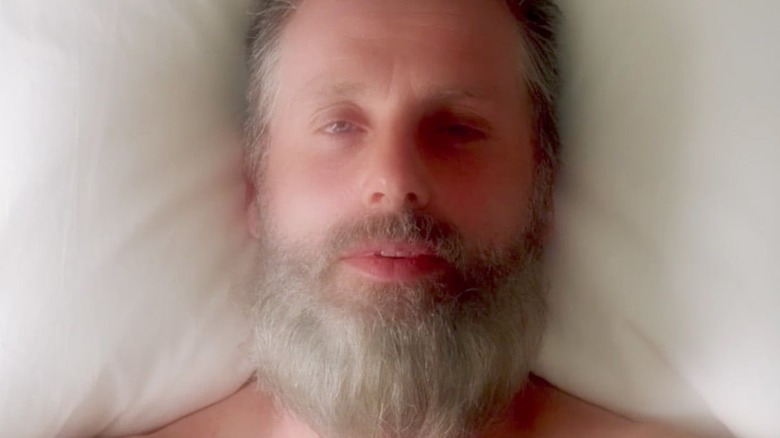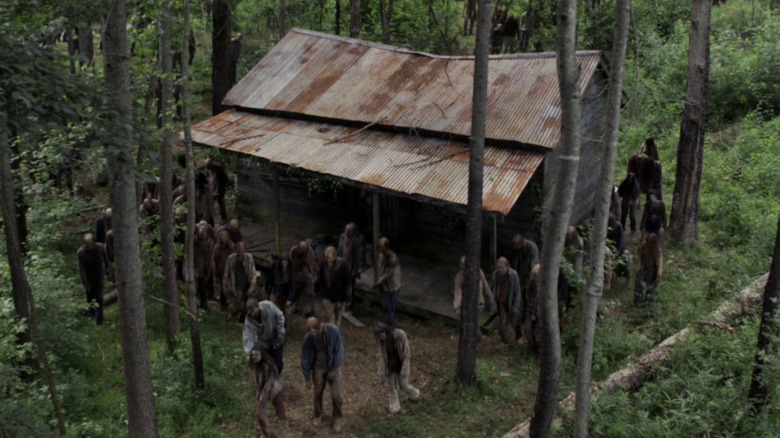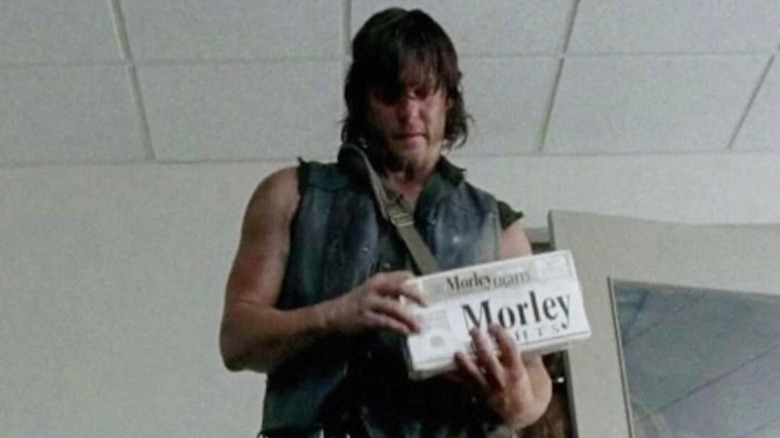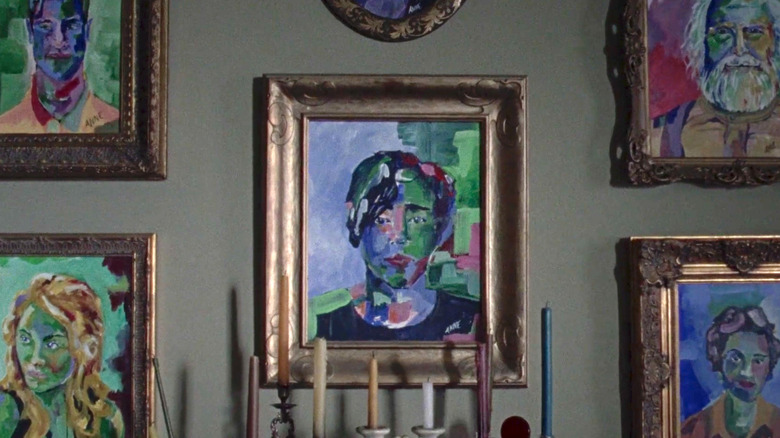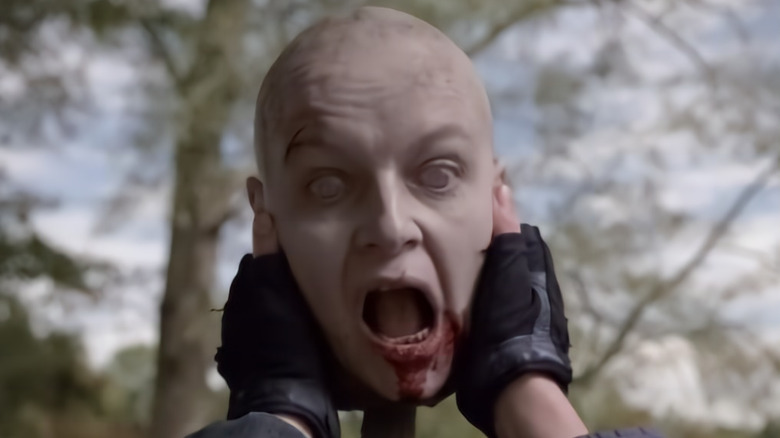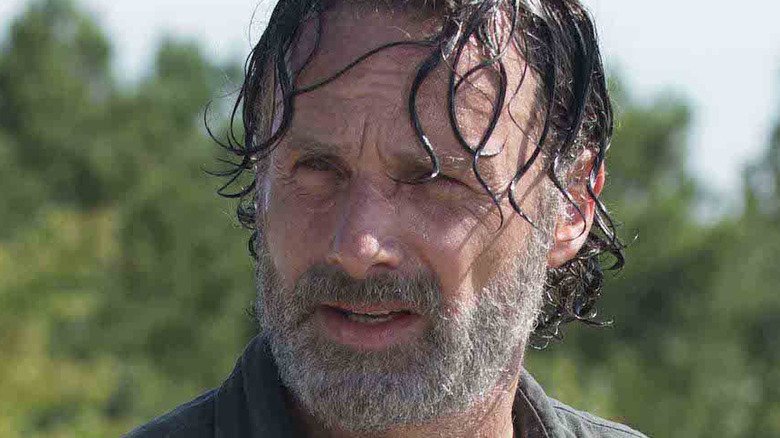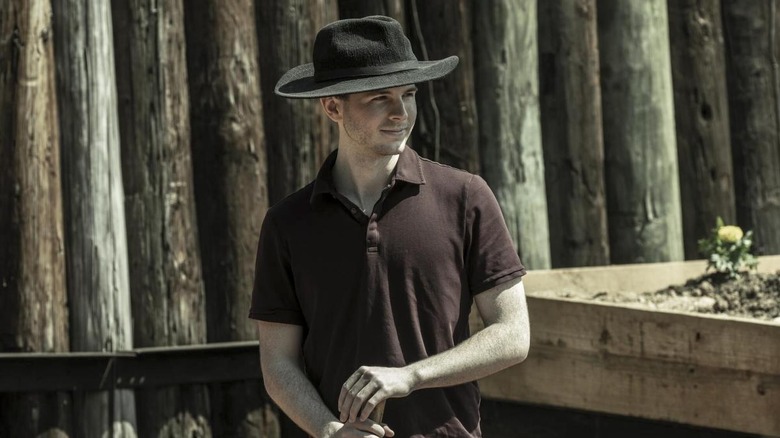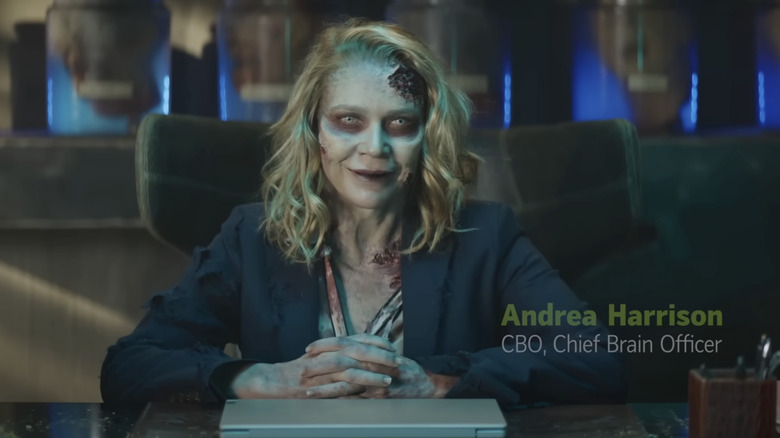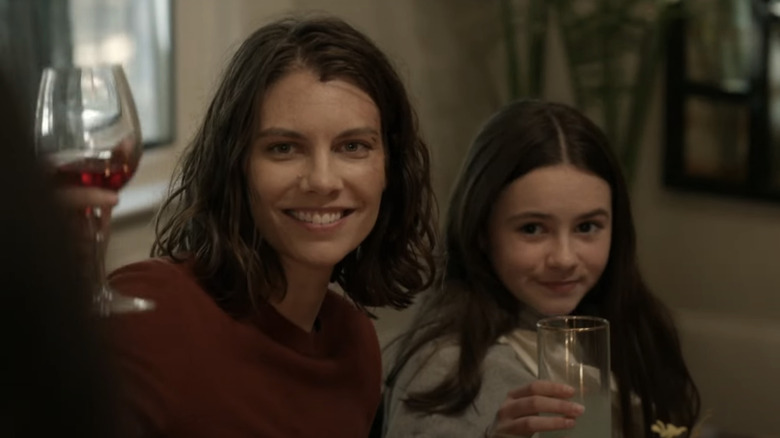Small Details You Missed In The Walking Dead
The end is nigh for the 11th season of "The Walking Dead," and so too ends the series after a historic 12-year run. As the series comes to a close, a number of characters and storylines will be finally be released from their suffering and laid to rest, while a handful of others will live on in the form of brand new spinoffs and potentially a handful of movies. The series' mastery of dramatic storytelling and grounded tone have ensured that the franchise –- much like its titular, relentless revenants -– will never truly die. "The Walking Dead" will keep walking, and that's largely (and ironically) because the show has always been so alive.
The show's masterminds, like original comic creator Robert Kirkman and its many showrunners, have imbued the series with a pervasive sense of vigor throughout its run, and they've done so by going the extra mile in production and by fostering a truly fun work environment. Simply put: the cast and crew behind "The Walking Dead" care about their program, and it shows on screen.
One of the best ways for fans to get a glimpse of this passion is to hunt for the show's many Easter eggs. Woven into the entire series are fun connections, callbacks, parallels, teasers, and references that make it apparent just how much this cast and crew love what they do. To help you push through the crowd of shambling, moaning moments in the show's history and reach that treasure trove, here are some small details you missed in "The Walking Dead."
The first walker lives
From the first few minutes of the "The Walking Dead" pilot, it's clear that this series is not just another zombie story — and not just because the show makes a point to stay away from the "z" word. No, the show sets itself apart by inventing a world in which zombies aren't a part of the zeitgeist, and so there's no precedent for the tongue-in-cheek camp of, say, an Edgar Wright. Instead, the walkers are treated as people, and every one of their deaths, undeaths, and even their second deaths hit characters close to home. That infusion of existentialism was apparent from the very first walker to appear on the show.
Rick Grimes meets his first walker and she's a small, young girl, complete with braces and a teddy bear. When he puts her down, he feels it, and so do fans. The walker, then known only as "Little Girl Walker," was played by actress Addy Miller. When "The Walking Dead" reached its Season 8 premiere, the showrunners decided to honor the series' earliest moments and recast Miller as another walker. Miller, now quite grown up, plays another walker in the eighth season opener, and her "new" walker is practically built from callbacks. She has the same cross-crossing scar on her right forehead and the same open, deformed right cheek. The nod was a fun one, especially when you consider how it implies that walkers still age, develop, and even have their braces removed.
Dale's speech returns
In the Season 1 episode "Vatos," the survivor group asks sweet, old Dale (Jeffrey DeMunn) about the watch he always wears and consistently winds. Citing the assumption that the world has come more or less to its end, the group asks Dale what use he has for timekeeping. In response, Dale defends his temporal fixation by reinterpreting a passage from William Faulkner's "The Sound and the Fury." He half-quotes and half-posits that the watch is a "mausoleum of all hope and desire" and that its importance is "not that you may remember time, but that you may forget it for a moment now and then and not spend all of your breath trying to conquer it."
For Dale, and for the overarching theme of the series, the speech is an important one. It touches on the need for accepting one's present circumstances instead of being ruled by regrets and hypotheticals. It also, through its use of the mausoleum metaphor, suggests that those who are trapped by time are the true dead ones, not the unburdened walkers. The moral persists, at least through the end of Season 5, which ends with five episodes titled "Remember," "Forget," "Spend," "Try," and "Conquer." The five words in a row represent five important points in Dale's speech, also in that same order.
A horde of famous zombies
"The Walking Dead" is notorious for its blink-and-you'll-miss-them references to other franchises, characters, and actors. Some, like Johnny Depp's "cameo," are simply sly reuses of props or cheeky special effects. Sometimes, however, actual celebrities make their way into the show, most often hidden under pounds of fake blood and rotting skin. The franchise is one of the biggest in recent decades, and as such, has attracted its fair share of celebrity fans who have opted to join the "The Walking Dead" universe by shuffling around in a scene's background, dripping flesh and stiffly lurching toward nowhere.
The Season 9 episode "Scars" featured Chris Hardwick as a walker clumsily pawing at Judith. Legendary Anthrax guitarist Scott Ian was in "Remember" as a walker who accosts Rick and Carl. Longtime voice and character actor M. C. Gainey took an unheralded role as a walker in "Slabtown." All-star Pittsburgh Steeler Hines Ward had a turn as a walker in "The Suicide King." Even series executive producer, director, and special effects supervisor Greg Nicotero donned the walker makeup for the episode "Hunted," wherein he rips a chunk out of Agatha's arm.
Notice the clocks
Speaking of Greg Nicotero, the SFX artist turned producer/director is at the heart of many of the best "The Walking Dead" Easter eggs and small details. With his hand on the pulse (or undead equivalent) of both the show's effects and its cinematography, Nicotero has long been in a unique position to slip whatever he desires into the final product, through one means or another.
Speaking to the crowd at the 2014 Walker Stalker Convention, Nicotero revealed one of the show's longest-running and most consistent visual bits, saying, "Every episode that we shoot we adjust the time on the watches and the clocks to whatever episode it is we're shooting."
Since the reveal, a number of fans have verified the trend, and the show's repeated emphasis on time as a narrative and thematic device has pointed to the bit even further. Virtually every time a clock or watch appears in an episode of "The Walking Dead," its hands are set to the episode's production code, meaning a clock in the background of Season 1, Episode 10 would read 1:10 or some variation thereof. We mentioned how Dale's speech emphasized the importance of time, and the long-running clock bit drives that concept home.
Teenage Mutant Ninja Turtles
The Season 6 episode "Here's Not Here" was special for a number of reasons, including its unprecedented (for a non-opener and non-finale) 90-minute runtime and its heavy focus on Morgan, the fan favorite who at that point, had only rarely received significant screen time. But to some viewers, the episode was special not for any "The Walking Dead" moments but for its possible reference to another major comic series, the Teenage Mutant Ninja Turtles.
The episode features the introduction and sole appearance of a character known only as Eastman, which Turtles fans will recognize as the last name of one of the TMNT co-creators, Kevin Eastman. For a lengthy sequence in the episode, Eastman sports a shirt with a picture of a turtle that reads, "Save the Terrapins." While in his turtle shirt, Eastman wields a bo staff — the signature weapon of Ninja Turtle Donatello – and even teaches Morgan the martial art known as Aikido. Those details alone are enough to suggest that any coincidence is unlikely, and several other minor details -– like Morgan sharing a last name with Turtles ally Casey Jones — have cemented the sequence as an obvious homage in fans' minds.
Little Red Riding Hood
After 11 seasons and over 150 episodes, "The Walking Dead" has accrued a serious collection of bad guys and gals — or, as the show's dubious morality and grim utilitarianism would likely prefer, slightly more predatory guys and gals. Whether it's the walkers themselves, the Whisperers, the Terminus survivors, the Reapers, or any number of other groups of post-apocalyptic marauders, the show's protagonists have their pick when it comes to adversaries. One such group, The Wolves, has the distinction of foreshadowing their arrival more poetically than any other.
Though the Wolves didn't emerge as main antagonists until Season 6, the show's production team used Season 5 to establish the Wolves' bloodthirstiness, cruelty, and also their penchant for ironic literary allusions. In the Season 5 episode "Conquer," Daryl and Aaron spot a man walking alone through a field, sporting a bright red poncho and hood. Though the pair lose track of the red poncho man, as he is officially known, viewers are shown his ultimate fate. Later in the same episode, the Wolves brutally murder the red poncho man, and the symbolism was not lost on viewers. After all, there's been at least one other confrontation between a red-hooded human and a vicious wolf.
100th episode callbacks
We mentioned the Season 8 premiere, "Mercy," before, as it included the return of the show's very first walker. But the episode, not only a season premiere but also the show's 100th episode overall, doesn't restrict itself to one fun reference. Instead, it revels in reminding viewers of times past, characters lost, and solid continuity when it comes to props.
For one thing, young Miller wasn't the only walker actor to return. Joe Giles, who played one of the first walkers seen in the pilot, also returns as a new flesh-eater (though he had also returned before). On top of that, the episode's cinematography is packed with direct shot-for-shot copies of shots from the pilot. Just like in the pilot, Rick wakes up from an injury in a hospital bed and rolls over to ponder the vase of flowers at his bedside. This time, however, the flowers are in bloom –- there was no coma and apocalypse to wilt them. Many other shots are repeated. In particular, much of the sequence from the pilot where Rick searches for gas and surveys the wreckage of the gas station and highway is repeated in "Mercy" almost exactly, though Carl now searches in his father's stead.
The Evil Dead
Series bigwig Greg Nicotero is back, as he very purposefully laced Season 9 with references to one of his favorite film franchises (as well as one of his first gigs), the "Evil Dead" films. In Season 9, Episode 5, "What Comes After" — which was also the last appearance of series lead Rick Grimes (Andrew Lincoln) — two distinct nods to the cult horror classics can be seen. When the heavily-injured Rick escapes a zombie horde, he takes refuge in a dilapidated, abandoned cabin. Once inside, Rick scans the cabin's interior and it becomes clear to fans that both the cabin and its contents are overt "Evil Dead" references.
The cabin exterior itself is a close replica of the cabin which provided the setting for 1981's "The Evil Dead" and 1987's "Evil Dead II." Inside, Rick spots a mounted deer head, clearly the same one that came to life in "Evil Dead II," as well the evil grimoire that launched the franchise's whole story, the Necronomicon. Speaking with Entertainment Weekly, Nicotero confirmed that the many references were no coincidence, and even pointed out another one elsewhere in the same season.
Connected worlds
Given the many homages and references hidden throughout "The Walking Dead," as well as the show's deliberately vague backstory, there have been many attempts by fans over the years to place the events of "The Walking Dead" in other franchises' universes. As we just hinted at, "The Evil Dead" is one such potential connection. Another of the most popular theories is that "Breaking Bad" took place in "The Walking Dead" canon shortly before the walker apocalypse, and the theory has a solid foundation of evidence.
Still, other theories exist. One suggests that the sinister Umbrella Corporation from the "Resident Evil" franchise is behind the events of "The Walking Dead." They certainly have experience in creating zombie apocalypses, and some fans have claimed that the Umbrella Corp's octagon logo is hinted at in the show's background. Another theory with potentially more traction is the idea that "The Walking Dead" takes place in the "X-Files" universe. The most commonly cited piece of evidence is that "The Walking Dead" has shown Morley cigarettes, the same smoked (like a chimney) by the Cigarette-Smoking Man in dozens of "X-Files" episodes. To be fair, the fake Morley brand has also appeared in shows as diverse as "The Twilight Zone" and "Friends," though never at the same frequency as they do in "The X-Files."
Glenn remembered
Easily one of the most iconic and enduring scenes in all of "The Walking Dead" is the scene in "The Day Will Come When You Won't Be" in which Negan murders Abraham and Glenn, the latter of which was perhaps the show's most gruesome moment. The scene even made such an impression that Dave Chappelle spoofed it during his return to sketch comedy when hosting "Saturday Night Live." The horrific scene was made even worse by the fact that Glenn's wife Maggie was forced to watch his murder in person, helpless to stop it. Viewers were reminded of Maggie's pain two years later (almost to the day) in the Season 9 episode "The Bridge."
In "The Bridge," we see the interior of Maggie's office in the Barrington House at the Hilltop settlement. One of her walls is covered in colorful, expressionist portraits, six of which can be seen clearly. Eagle-eyed fans were quick to debate the paintings' contents and origin, though eventually, the show made it clear that Anne had painted the pieces for Maggie. Each portrait is a loved one that Maggie has lost, including her father Hershel, sister Beth, and her dearly departed husband, Glenn.
Negan calls his shot
Season 10 features one of the show's most tantalizing nods to the comic series and potential foreshadowing, beginning in Episode 9, "Squeeze." In the episode, the Whisperer leader Alpha comes on to Negan, offering sex as a "crass reward" for Negan's help. Wary, Negan asks her, "Wait, wait. This isn't some kind of praying mantis situation, is it? Where you cut off my head afterwards?" This is an understandable question on the surface, as Alpha could kill whomever she wanted at a moment's notice. But readers of the comic series knew that this line contained a deeper meaning, as in the comics, the roles are reversed and Negan actually cuts Alpha's head off.
Fans didn't have to wait long to find out if this was simply a wink to comic readers or an actual bit of foreshadowing, as the truth was made clear three episodes later in "Walk With Us." In the episode, Negan does indeed kill Alpha by cutting her head off. In a subtle and slanted way, his "praying mantis" remark from three episodes earlier was him calling his shot. As he said just before murdering Glenn, he is a man of his word.
The many hints that Rick still exists
Sadly, all good things come to an end. In the ninth season episode "What Comes After," series protagonist Rick leaves the show for good. The moment was always going to be huge, as the character was the show's driving force and emotional core for over eight years. With a show like "The Walking Dead," so focused on death, always ready to raise its stakes exponentially, and seemingly eager to kill off major characters, many fans expected Rick to end his run on the show by dying spectacularly. Instead, a still-living Rick flew off in a helicopter with Anne, his whereabouts unknown, but expected to return in his own movies.
Since then, any potential hints at Rick's existence or possible return have had fans buzzing. The helicopter that scooped him up was later revealed to belong to the Civic Republic Military, and their unmistakable three-ring logo has shown up at different times, even crossing into the spinoff series "Fear the Walking Dead." There's also the most direct hint at Rick's existence yet, when Michonne finds Rick's boots in a shipwreck, alongside a cellphone upon which was drawn crude likenesses of Michonne and Judith — Rick's two closest family members. The phone also featured some Japanese characters, which "The Walking Dead" overlord Scott Gimple confirmed translated to "believe a little bit longer." Until Rick's return in some unknown "Walking Dead" movie on some unknown date, all fans have is their belief.
Carl Grimes: alive and farming
More than absolutely anything else, "The Walking Dead" fans were desperate for one return in the series finale: a certain Grimes man who has been absent for multiple seasons now. Luckily for all of us, our wishes came true, and Grimes finally made another onscreen appearance. That's right, the series finale finally brought back Carl Grimes (Chandler Riggs) for a long-anticipated background cameo as a farmer. What, were you expecting to see Rick (Andrew Lincoln) again? Well, yes, both fan favorites (and former protagonists) Rick and Michonne (Danai Gurira) return, teasing the future of the "Walking Dead" franchise as a whole, but more importantly, we got a sly return from Riggs, all (or mostly) grown up.
In an interview with EW, showrunner Angela Kang revealed the surprising simplicity of Riggs's return, saying the actor "was in town and he just asked to visit to say hi to friends ... And then they were doing these scenes and needed some extras, and Greg [Nicotero] was like, 'Well, you want to go for it? Get in there! Go get in the back.'" The scene in question involves a handful of characters in Hilltop, including Daryl (Norman Reedus), discussing their plans for the future, while a number of unnamed colonists tend the land in the background. One of those unnamed colonists had a name, at least in another life: Carl Grimes.
The Walking Deadvertising
If you watched "The Walking Dead" series finale live and actually sat through the commercials, you were treated to a series of unexpected and hilarious advertisements for different companies connected by one standout, shambling component: all of them featured former "The Walking Dead" actors, seemingly returned to (un)life as zombies. The ad block is officially known as "The Walking Deadvertising," or at least that's the name chosen by its creator — far from one of the first names you would expect behind a "The Walking Dead" campaign: Ryan Reynolds.
If you're a human being with a pulse (which may not be a given in this apocalyptic setting), then you've almost certainly noticed the bevy of memorable commercials, commentaries, parodies, and even music videos that Reynolds has been a part of over the last decade or so. All of them have come from Maximum Effort, Reynolds' production company, and the company's latest piece of charming novelty is "The Walking Deadvertising."
The block consists of five ads for companies DoorDash, Autodesk, Ring, Deloitte, and MNTN Performance TV. Each stars a zombie played by a former "Walking Dead" actor, easily the most exciting of which was the MNTN Performance TV ad. In it, Laurie Holden reprises her role as Andrea Harrison, one of the series' leading characters in its first three seasons, closing out her dialogue by revealing "I ate Ryan Reynolds' brain. I'm still hungry."
The Sunday dinner
For years, "The Walking Dead" has been a dominant force in TV drama, mainly thanks to its complex characters, nuanced moral exploration, and — most relevant to the finale's Sunday dinner callback — unyielding commitment to subtle, patient payoffs.
In the series finale, the remaining survivors among the main cast gather for a simple, wholesome family dinner on a Sunday. They chat, joke, toast to each other, and the scene ends without any conflict or drama — just well-earned satisfaction. Yet every moment is positively drenched in irony (in the traditional sense) and a full palette of emotions, all thanks to the scene that set it up, all the way back in Season 7 Episode 1.
After the notorious scene in which Negan murders Ford and Glenn with a baseball bat, he gives Rick one of his characteristic nuggets of nihilistic wisdom, saying, "Bet you thought you were all going to grow old together. Sitting around the table at Sunday dinner in the happily ever after. No, doesn't work like that, Rick. Not anymore." To add poignancy to the horror, that episode ends with a dream sequence in which Rick imagines them all having a nice dinner together, one that was now impossible.
Six years later, during the series finale, the dream actually becomes a reality. The peaceful dinner is real, and to make it even more impactful — Negan chooses to avoid the meal, a wordless but powerful show of regret and growth.
